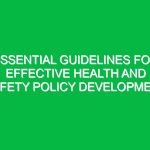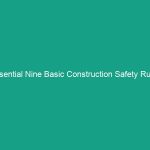“`html
Essential New Equipment Guidelines: Avoid Critical Safety Risks Today!
Good morning team,
Today, we’re diving into a crucial topic that impacts each of us in our daily operations: Essential New Equipment Guidelines. Understanding these guidelines is vital for our safety and well-being. With the introduction of new equipment, we can face critical safety risks that can affect not only our work but also our lives. By adhering to these guidelines, we can prevent accidents, injuries, and ensure a safer work Environment.
Understanding Essential New Equipment Guidelines
The Essential New Equipment Guidelines are a set of protocols designed to ensure that any new equipment introduced to our workplace meets safety Standards and operates efficiently without posing risks to our health. These guidelines are essential because they help us identify potential Hazards, ensure compliance with safety Regulations, and promote a culture of safety within our organization.
Many employees might think that new equipment is automatically safe just because it’s new. However, this misconception can lead to serious accidents if proper Safety Measures are not followed. It’s crucial to understand that new equipment might come with its own set of challenges that need to be addressed proactively.
Key Hazards, Risks, and Safety Considerations
When new equipment is introduced, it can bring about various hazards, including:
- Mechanical Failures: New machinery may have defects or may not have been tested thoroughly.
- Operator Error: Employees might not be adequately trained to use new equipment, increasing the risk of accidents.
- Incompatibility with Existing Equipment: New equipment may not work well with older systems, leading to malfunctions.
- Improper Setup and Maintenance: New equipment may require specific setup or maintenance Procedures that, if ignored, can lead to dangerous situations.
Ignoring safety protocols can lead to severe consequences, including injuries, equipment damage, and even fatalities. It’s critical to be aware of these risks and take appropriate actions to mitigate them.
Best Practices, Procedures, & Actionable Advice
To ensure safety when dealing with new equipment, follow these Best Practices:
1. Conduct a Thorough Risk Assessment
Before introducing new equipment, a comprehensive risk assessment should be conducted. This assessment will help identify potential hazards and allow us to implement necessary Control Measures.
2. Training and Certification
All employees should receive proper Training on the new equipment before use. This includes:
- Understanding how the equipment operates.
- Learning about safety features and emergency shutdown procedures.
- Receiving hands-on training under the supervision of a qualified instructor.
3. Follow Manufacturer Guidelines
Always refer to the manufacturer’s guidelines and manuals. These documents provide vital information about safe Operation, maintenance, and troubleshooting.
4. Implement a Maintenance Schedule
Establish a regular maintenance schedule to ensure all equipment is functioning correctly. This includes routine checks, servicing, and addressing any identified issues promptly.
5. Create Clear Operating Procedures
Develop clear, concise operating procedures for using the new equipment. Make these procedures easily accessible to all employees and ensure they are regularly updated.
6. Encourage Reporting of Safety Concerns
Foster an environment where employees feel comfortable reporting safety concerns or incidents related to new equipment. This feedback is crucial for continuous improvement and safety enhancement.
Real-World Example
Let’s consider a case study involving a manufacturing plant that introduced a new conveyor belt system. Initially, employees were not adequately trained, leading to several near-miss incidents due to improper usage. After implementing a comprehensive training program and establishing clear operating procedures, the number of incidents dropped significantly, highlighting the importance of following safety protocols.
Regulations, Standards, and Compliance
Compliance with safety regulations is not just a legal obligation; it is essential for protecting our workforce. Familiarize yourself with the relevant OSHA standards, as well as any company-specific policies regarding new equipment. Key regulations include:
- osha Standard 1910: General Industry Standards that cover equipment safety.
- ISO 45001: International standard for Occupational Health and safety.
Adhering to these regulations not only ensures compliance but also fosters a culture of safety that Benefits everyone in the workplace.
Employee Engagement & Discussion
Now that we’ve covered essential guidelines, let’s open the floor for discussion. What safety challenges have you encountered related to new equipment? How can we improve our training or procedures? Your insights are invaluable in enhancing our safety protocols.
Conclusion & Key Takeaways
In summary, understanding and following the Essential New Equipment Guidelines is crucial for maintaining a safe work environment. Remember to:
- Conduct thorough risk assessments.
- Provide adequate training for all employees.
- Follow manufacturer guidelines and maintain compliance with safety regulations.
Let’s prioritize safety by applying these practices daily. Thank you for your attention and commitment to making our workplace safer. Together, we can avoid critical risks and ensure a productive and healthy environment for everyone.
“`


